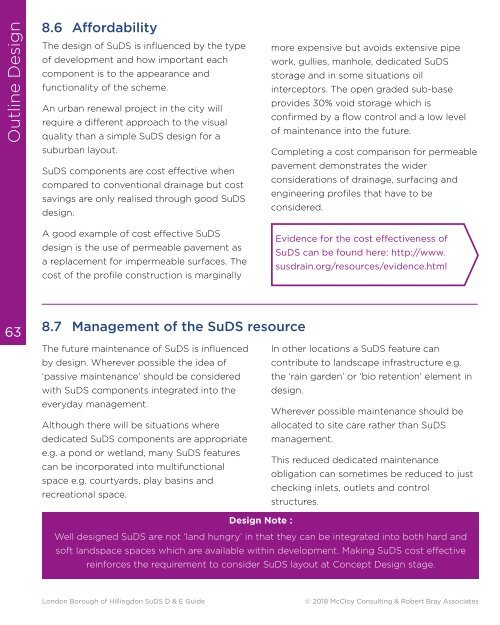Hillingdon SuDS Design & Evaluation Guide
Create successful ePaper yourself
Turn your PDF publications into a flip-book with our unique Google optimized e-Paper software.
Outline <strong>Design</strong><br />
8.6 Affordability<br />
The design of <strong>SuDS</strong> is influenced by the type<br />
of development and how important each<br />
component is to the appearance and<br />
functionality of the scheme.<br />
An urban renewal project in the city will<br />
require a different approach to the visual<br />
quality than a simple <strong>SuDS</strong> design for a<br />
suburban layout.<br />
<strong>SuDS</strong> components are cost effective when<br />
compared to conventional drainage but cost<br />
savings are only realised through good <strong>SuDS</strong><br />
design.<br />
more expensive but avoids extensive pipe<br />
work, gullies, manhole, dedicated <strong>SuDS</strong><br />
storage and in some situations oil<br />
interceptors. The open graded sub-base<br />
provides 30% void storage which is<br />
confirmed by a flow control and a low level<br />
of maintenance into the future.<br />
Completing a cost comparison for permeable<br />
pavement demonstrates the wider<br />
considerations of drainage, surfacing and<br />
engineering profiles that have to be<br />
considered.<br />
A good example of cost effective <strong>SuDS</strong><br />
design is the use of permeable pavement as<br />
a replacement for impermeable surfaces. The<br />
cost of the profile construction is marginally<br />
Evidence for the cost effectiveness of<br />
<strong>SuDS</strong> can be found here: http://www.<br />
susdrain.org/resources/evidence.html<br />
63<br />
8.7 Management of the <strong>SuDS</strong> resource<br />
The future maintenance of <strong>SuDS</strong> is influenced In other locations a <strong>SuDS</strong> feature can<br />
by design. Wherever possible the idea of contribute to landscape infrastructure e.g.<br />
‘passive maintenance’ should be considered the ‘rain garden’ or ‘bio retention’ element in<br />
with <strong>SuDS</strong> components integrated into the design.<br />
everyday management.<br />
Wherever possible maintenance should be<br />
Although there will be situations where<br />
allocated to site care rather than <strong>SuDS</strong><br />
dedicated <strong>SuDS</strong> components are appropriate management.<br />
e.g. a pond or wetland, many <strong>SuDS</strong> features<br />
This reduced dedicated maintenance<br />
can be incorporated into multifunctional<br />
obligation can sometimes be reduced to just<br />
space e.g. courtyards, play basins and<br />
checking inlets, outlets and control<br />
recreational space.<br />
structures.<br />
<strong>Design</strong> Note :<br />
Well designed <strong>SuDS</strong> are not ‘land hungry’ in that they can be integrated into both hard and<br />
soft landspace spaces which are available within development. Making <strong>SuDS</strong> cost effective<br />
reinforces the requirement to consider <strong>SuDS</strong> layout at Concept <strong>Design</strong> stage.<br />
London Borough of <strong>Hillingdon</strong> <strong>SuDS</strong> D & E <strong>Guide</strong><br />
© 2018 McCloy Consulting & Robert Bray Associates


